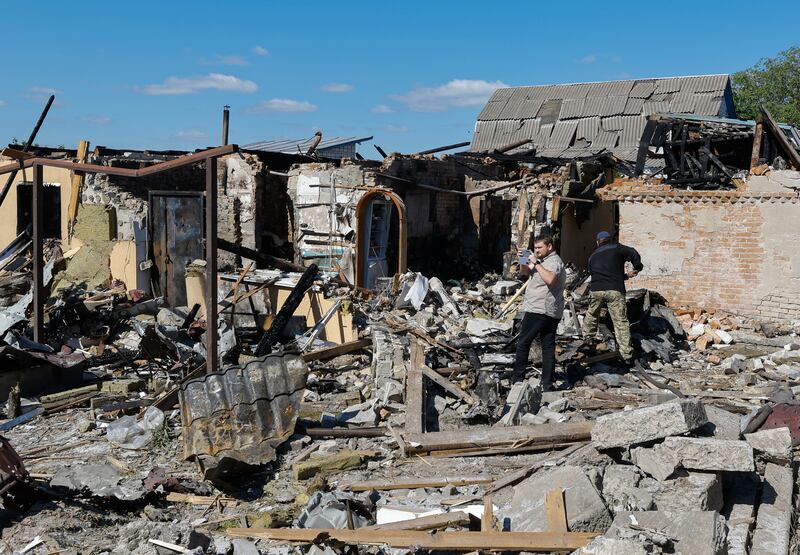Ukraine applied to join the European Union four days after Russia’s full-scale invasion in 2022. It is unlikely to become a full-fledged member before 2030, if then. The long wait seems unfair considering Ukraine’s European history and the price it has paid in blood for its European aspirations.
Vikings from present-day Sweden founded the medieval Kyivan Rus state in the late 9th century. At its apogee in the 11th century, under the rule of Grand Prince Yaroslav the Wise, Kyiv was the most opulent capital in Europe after Constantinople, protected by two walls and boasting hundreds of gold onion-domed churches. Poets and musicians performed in Yaroslav’s court, renowned for its culture. Yaroslav married Ingegerd, the daughter of the king of Sweden, known to Ukrainians as Iryna.
Their daughters, Elizabeth, Anastasia and Anna, married the kings of Norway, Hungary and France. A fourth daughter, Agatha, is believed to have married into the English royal family. Ukrainians refer to Yaroslav as “the father-in-law of Europe”.
Trade routes from western Europe, Asia and Arabia converged in Kyiv. French King Henri I sent an envoy to Yaroslav in 1048 to ask for the hand of his youngest daughter, at a time when Kyiv far outshone France. Another French ambassador accompanied Anna – Anne de Kiev to the French – up the Dnipro River, across Lake Ladoga and the Baltic Sea and down the coast of Frisia to her marriage and coronation in Reims. In her dowry, Anne brought bearskins and sables, Persian silk, Armenian perfumes, caviar and vodka.
The Mongol horde ended the Kyivan Rus dynasty when it sacked Kyiv in 1240. The Mongols also invaded the principality of Muscovy, isolating present-day Russia for nearly two and a half centuries, infusing it with their bellicose habits.
Ukraine’s history is also Mongol, Cossack, Russian, Slavic and Turkish. But its citizens see Europe as a beacon of culture, democracy, prosperity and human rights
The Mongols could not isolate Kyiv from Europe. The Polish-Lithuanian Commonwealth ruled much of present-day Ukraine from the 16th until the 18th century, when the Austro-Hungarians took western Ukraine until the first World War.
Swedish King Charles XII allied himself with the Cossack Hetman Ivan Mazepa. They were defeated by Russian Czar Peter I at the battle of Poltava in 1709. Peter took the name Russia from Kyivan Rus, which is why Ukrainians say Russia stole their history.
[ Collisions by Michael Kimmage: The ripple effects of war in UkraineOpens in new window ]
The blue and yellow flags of Sweden and Ukraine may be the legacy of their historic affinity. Scandinavians are among Ukraine’s strongest supporters against Russia.
Belgium, Britain, France and Germany industrialised the eastern Donbas region of Ukraine in the 19th century. A direct train ran from Brussels to Donbas, which was known as Belgium’s tenth province. The British founded Donetsk city, and John Hughes from Wales built the metallurgy plant which produced most of the Russian empire’s iron.

Ukraine’s history is also Mongol, Cossack, Russian, Slavic and Turkish. But its citizens see Europe as a beacon of culture, democracy, prosperity and human rights.
The Ukrainian philosopher Constantin Sigov teaches at Ukraine’s oldest university, Kyiv-Mohyla, founded in 1615. His Spirit and Letter publishing house translates European works into Ukrainian. “In the 17th century, courses at my university were taught in Latin,” Sigov said in an interview. “Kyiv was a centre of Baroque art and architecture, of Enlightenment ideals and Romantic literature.”
To this day, Russia perpetuates the myth that Ukraine was a country of collaborators and that it was and is governed by Nazis
Most important, Sigov says, Ukraine exemplifies the suffering and spirit of resistance forged in Europe’s most terrible upheaval, the second World War. He cites the speech delivered before the Bundestag by Yale Professor Timothy Snyder, a leading historian of Ukraine.
Snyder’s research established that Ukraine was Hitler’s principal war aim. All of Soviet Ukraine was occupied by the Nazis for most of the war. Soviet Ukraine lost the greatest number of lives to nazism of any European country: 3.5 million civilians were killed, mostly women and children. Three million Ukrainian soldiers died fighting in the ranks of the Red Army.
Yet to this day, Russia perpetuates the myth that Ukraine was a country of collaborators and that it was and is governed by Nazis. “More Ukrainians fought and died on the allied side than French, British and Americans put together,” Snyder said. As for collaboration with Nazis, he added, “Russians collaborated, Crimean Tatars collaborated, Belarusians collaborated. Everyone collaborated… Far more Ukrainians died fighting against the Wehrmacht than fighting on the side of the Wehrmacht.”

David Rieff on Ukraine, Gaza, populism and the death of art
More Russians fought in the ranks of the collaborationist “Russian Liberation Army” led by Andrey Vlasov, a defector from the Red Army, than Ukrainians worked with the Nazis, Sigov notes. Ukrainians fought the “dual totalitarianism” of nazism and Soviet tyranny well into the 1950s.
In a lecture at the École Normale Supérieure in Paris last January, Sigov quoted the poet Paul Valéry at the end of the first World War. “We other civilisations know now that we are mortal.” The theme was taken up by President Emmanuel Macron in his April 25th speech at the Sorbonne. “Our Europe can die,” Macron said.
Because Europeans conceived of their Union as a haven of peace, they all but forgot the importance of resisting totalitarianism, Sigov says. The war in Ukraine has awakened them. “Ukrainian resistance is the antidote to this amnesia in Europe. In this way, Ukraine is a necessity for Europe.”
- Listen to our Inside Politics Podcast for the latest analysis and chat
- Sign up for push alerts and have the best news, analysis and comment delivered directly to your phone
- Find The Irish Times on WhatsApp and stay up to date













